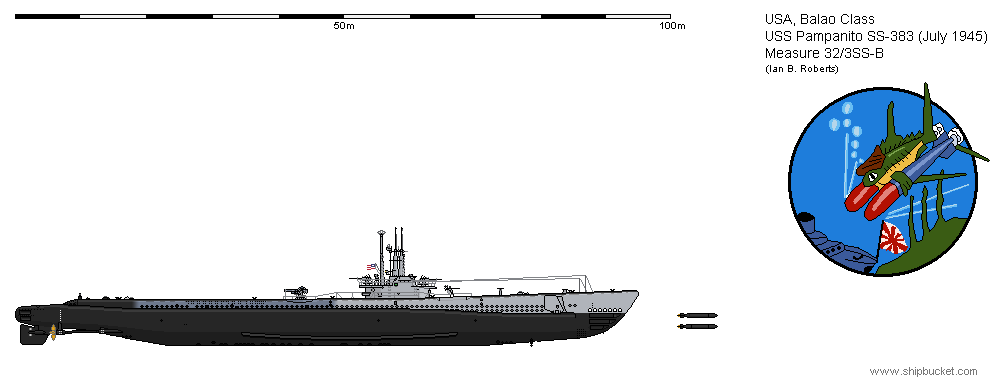|
Gefallen Engel U-666
Join Date: Jul 2013
Location: On a tilted, overheated, overpopulated spinning mudball on Collision course with Andromeda Galaxy
Posts: 27,886
Downloads: 22
Uploads: 0
|

Quote:
American fleet submarines enjoyed a considerable advantage from very early in World War II, as they were equipped with basic radar from the first days of the Pacific conflict, and added more advanced units within the first year of the war.
presentation/18/ SD RADAR:
The earliest radar installed in the fleet boats was the SD air search radar. This was a very basic unit. Operated from the conning tower, the SD radar was only vaguely directional. It was capable of warning that a plane was within about 6 miles of the boat, but couldn’t really pinpoint a bearing, or give much in the way of information.
The main advantage it conferred was that it warned of aircraft in the vicinity, and could also indicate if they were coming closer, giving the boat time to dive and elude. The obvious problem was that it was still short range—6 miles can be covered in just over a minute at 300 mph—and was of very little use for surface searches. Getting away from enemy aircraft was important, but the priority was hunting down enemy ships, and something was needed to help with that goal.
Late in the war, SD was replaced by SV radar, which used a rotating directional antenna, and could give a range and bearing on the target. It was also capable of being linked to boat’s PPI, and had provisions for IFF (Identification, Friend or Foe) capability.
SJ RADAR:
The next major advance came with the installation of SJ Radar, beginning in mid-1942. Unlike the SD unit, the SJ was a directional radar, which could be used to sweep the surrounding sea for targets. The primary limitation on range was the height of the retractable mast, radar being limited to line-of-sight.
In the Pacific, the United States enjoyed a considerable advantage over the enemy. While the German u-boats were forced to spend most of their time submerged, kept down by the ubiquitous enemy radar on Allied ships and aircraft, the American submarines had the radar advantage over a Japanese fleet that largely lacked radar.
Japanese destroyers didn’t get radar until much too late in the war for it to do any real good. What was available mostly went to capital ships, and was mainly of a fairly primitive design, useful mostly for gunnery range finding. The fleet boats’ SJ radar was designed for search, ranging, and navigation, and was a much more advanced design.
In addition to conducting surface searches, the radar masts could also be extending above the water before surfacing, to check the area for enemy warships and aircraft. This was considerably more effective than using the periscope, particularly on dark nights.
PPI:
The next great advance in American submarine radar was the addition of a Plan Position Indicator (PPI) to the screen. This type of unit is common in even the cheapest small craft radar today, but at the time it was a revolutionary development.
The PPI superimposes a chart image on the screen, giving the operator and commander a much clearer idea of just where everything is. This could be extremely valuable when operating near a coast, since it was possible to match the chart on the PPI with the radar returns to get an exact position. (Radar waves bounce off of islands, too.)
PERISCOPE RADAR:
Late in the war, miniaturization had progressed to the point where it was possible to install a small radar antenna (ST) in the search periscope. This was used for obtaining an accurate range on a target. The sonar could also do this, but that required transmitting an audible “ping,” which could be heard by the target, warning them of the presence of a submarine. Most Japanese vessels were unable to detect the radar pulses, and so remained unaware until it was too late to elude.
The availability of these various forms of radar accounted for much of the effectiveness of the American fleet submarines in World War II. By giving warning of aircraft, radar allowed the boats to operate on the surface even in daylight, keeping the batteries charged, and greatly extending the distance that could be covered in a day. Even the SD radar could detect a plane beyond the visual range of the sharpest-eyed lookout.
As a surface search aid, radar again extended the visual range of a submarine’s lookouts. The antenna could be raised higher than a man could perch, giving it a broader horizon to search. And it could see through haze and fog, or on a moonless night, when a lookout might have trouble seeing the foredeck.
More importantly, because the submarines had radar, and the Japanese, for the most part, didn’t, it shifted the odds decisively in the direction of the submarines.
|
 Of some intertest to the persnickitous: Of some intertest to the persnickitous: http://shipbucket.com/forums/viewtopic.php?t=7962 http://shipbucket.com/forums/viewtopic.php?t=7962
Quote:
 This is PAMPANITO (SS-383) in July of 1945, at the conclusion of a refit period at Hunter's Point near San Francisco. She is camouflaged in Measure 32/3SS-B. This is PAMPANITO (SS-383) in July of 1945, at the conclusion of a refit period at Hunter's Point near San Francisco. She is camouflaged in Measure 32/3SS-B.
PAMPANITO (like the class leader BALAO) was a "government built" boat, with two rows of limber holes and a portside anchor. PAMPANITO was launched with a 4"/50-caliber deck gun, but the July 1945 refit period removed this gun in favor of the newer 5"/25 wet mount. PAMPANITO also received two 40mm Bofors Mark 3 single mounts on the fairwater, and the aft end of the fairwater itself was shortened to reduce the boat's silhouette when running surfaced. The SV air search radar sits on a mast aft of the periscope shears, with the SJ-1 surface search antenna ahead of it, and the ST range-only radar on the forward periscope. APR-1 radar countermeasures stub antennas sit atop the periscope shears, and the usual DF loop (for underwater HF reception) hangs between the shears, suspended from the topmost brace.
PAMPANITO would survive the war to become a museum in San Francisco,  CA. CA.
|
__________________

"Only two things are infinite; The Universe and human squirrelyness; and I'm not too sure about the Universe"
|